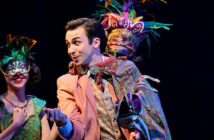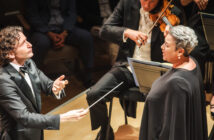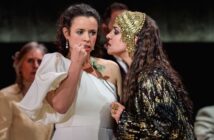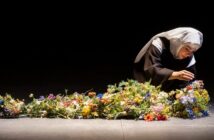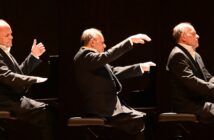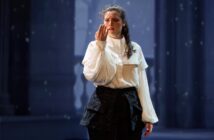By Joseph Stein, Sheldon Harnick and Jerry Bock
Director and Choreographer: Donna Feore
Set Designer: Allen Moyer
Musical Director: Shelley Hanson
Cast:
Tevye: Scott Wentworth
Golde: Kate Hennig
Tzeitel: Jennifer Stewart
Hodel: Jacquelyn French
Chava: Keely Hutton
Shprintze: Krista Leis
Saturday, June 15, 2013
Festival Theatre
Stratford Festival
Several weeks ago, in Texas, I found myself deeply moved and inspired by a fine Marc Chagall exhibition – Chagall: Beyond Color – at the Dallas Museum of Art. The show included numerous versions of the Green Violinist (1923-24), often fantastically perched on a roof of a Russian house. This experience proved to be excellent preparation for a fine new production of the musical Fiddler on the Roof at Stratford. While the work is clearly based on stories by Sholem Aleichem, Chagall’s unforgettable image is also at the heart of this profoundly Jewish yet universal expression of human tragedy and comedy.
Director Donna Feore adhered closely to the spirit and style of the original 1964 Jerome Robbins presentation in this production of Fiddler. She made no attempt to “make it different” simply to be different. It appeared to be enough for her to remain faithful to the original concept, and strive to be worthy of it.
Indeed, there was an honesty about this production that was most endearing. It started with Scott Wentworth’s superb Tevye. Lesser artists risk giving us an impression instead of a real character. Scott Wentworth was the real thing. Rising deftly to the big moments, he also found a way to bring humanity to the one-liners.
The others in the cast were also solid, offering us the high standard of dramatic and musical performance that we have come to expect at Stratford. The Russian choreography was brilliantly executed, with special kudos in order for the extraordinarily disciplined bottle dancers: Matt Alfano, Gabriel Antonacci, Stephen Cota and Julius Sermonia.
Kate Hennig (photo: right) gave as good as she got as Tevye’s wife Golde; Andre Morin was a fine young enterprising tailor; and Mike Nadajewski captured the essence of Perchik’s revolutionary fervor.
The dance sequences excited the audience time and again, but it was perhaps one particular scene – “The Dream” – that demonstrated the exceptional imagination animating this production. It was entertaining and it was magical in its use of masks and levitation. “Bravo” Allen Moyer (set design), Dana Osborne (costumes) and Michael Walton (lighting)!
Composer Jerry Bock’s musical score was not particularly innovative, even in 1964, but he had a keen ear for both Russian and Ukrainian dance music and for klezmer music. Some might say that given the seriousness of the ideas dealt with in the libretto, the music comes across as too slick and too popular, but then this is music popularized for success on Broadway.
Some might also say that Bock’s music coupled with Tevye’s near Borscht Belt jokes undermines the reality of the suffering of Jewish peasants under the Czar; these Fiddler Jews make a joke about everything, and when all else fails a song and a dance keeps them happy. In the end, these happy go lucky Fiddler Jews are not wiped out; they simply move to America, and live happily ever after. And some might say that’s the point of the story – making the best use of what you’ve got.
The essence of Fiddler on the Roof is tradition, and holding on to universal values in the face of change. Some of the changes portrayed in this production are technological – sewing machines increased efficiency in business, for example – a good thing. Other changes were life-threatening. Revolution was coming to Russia, but anti-semitism was embraced by the new regime as it had been by the old. Those Jews who had been able to emigrate only as far as Poland or Germany found to their horror that they had not gone nearly far enough.
Tears and laughter endear us to Tevye and his family, but the fate of the Jewish people was under far more of a threat than Fiddler on the Roof would suggest. Even in a production as brilliant as this one, one strains to ignore the difference between the entertaining Broadway version of the Jewish condition in this era and the far more disturbing truth as revealed in history books.
Paul Robinson<
/span> is the author of Herbert von Karajan: the Maestro as Superstar, and Sir Georg Solti: His Life and Music. For friends: The Art of the Conductor podcast, “Classical Airs.”





